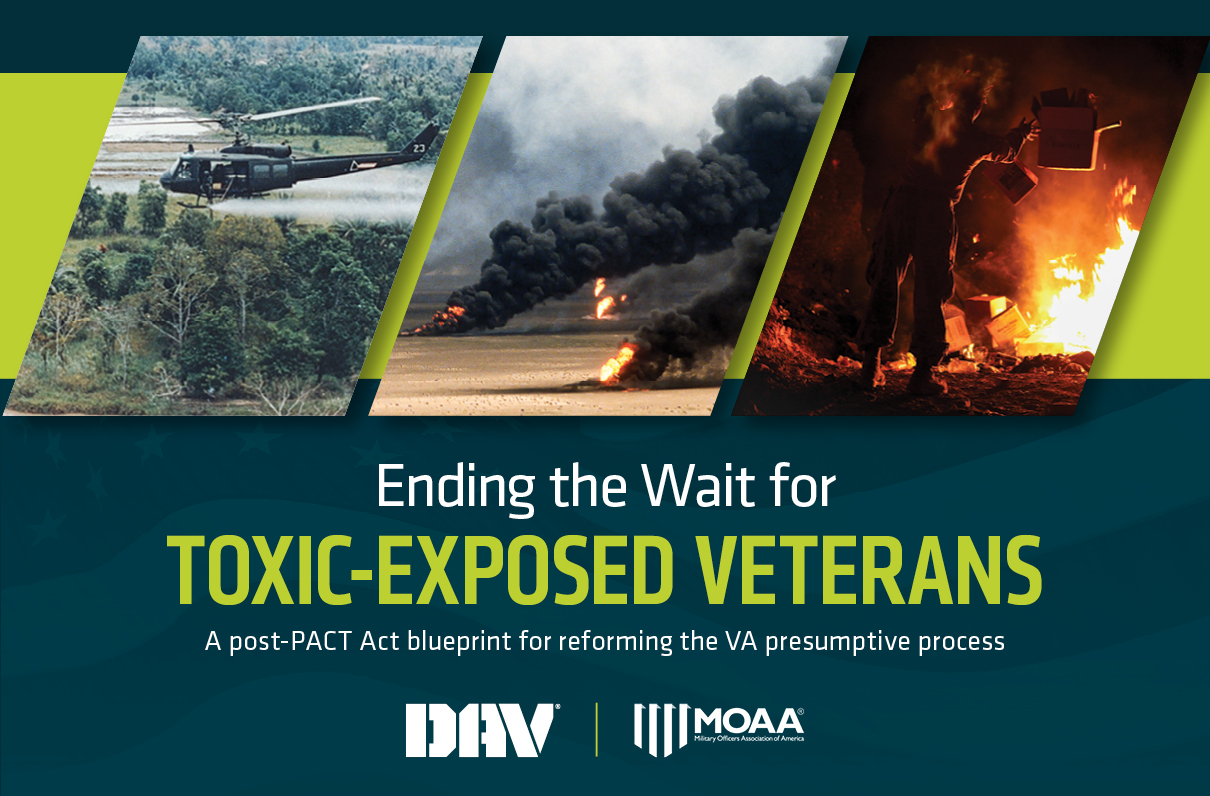Note from MOAA: This article was originally published at DAV.org in support of Ending the Wait for Toxic-Exposed Veterans, a joint DAV/MOAA report offering a blueprint for reforming toxic exposure-related benefits. Learn more about the report at this link.
Six years ago, retired Army Lt. Col. Gary Sauer was diagnosed with non-Hodgkin’s lymphoma, a type of blood cancer. He had no family history of cancer, and testing confirmed he wasn’t genetically predisposed.
But over his 22-year military career, Sauer — who was also diagnosed with a rare kidney disease — served at numerous installations known to have the presence of perfluoroalkyl and polyfluoroalkyl substances (PFAS).
These synthetic “forever chemicals” are found in everything from clothing to cookware. With enough exposure, PFAS have been shown to cause cancer, thyroid disease, reproductive problems and other health issues.
“It’s a disease that can just be monitored and treated,” Sauer said of his cancer diagnosis. “But you know, at the end of the day, it may result in losing my life over it.”
Although the Department of Defense recognizes more than 700 U.S. military sites known or likely to be contaminated with PFAS, the Department of Veterans Affairs doesn’t concede PFAS exposure to those who served at any of those locations.
That means affected veterans must prove their individual exposures and convince the VA the exposures caused their illnesses in order to receive benefits.
It’s a burden too many toxic-exposed veterans — including those with life-threatening illnesses — have to carry. A new report from DAV and MOAA reveals that, on average, these veterans have to wait more than 30 years to get access to the full range of health care and benefits they are owed and need. Some die before that ever happens.
In Ending the Wait for Toxic-Exposed Veterans, DAV and MOAA offer a blueprint for reforming how the VA and Congress handle service-related toxic exposures and the illnesses associated with them.
“While the PACT Act of 2022 helped millions of toxic-exposure veterans, it did not address all known military toxic exposures, nor did it ensure that future generations will have timely access to their earned health care and benefits,” said DAV Washington Headquarters Executive Director Randy Reese.
In the case of PFAS exposure, adopting the recommendations in DAV and MOAA’s report would remove many of the evidentiary, financial and political obstacles that prevent the VA and Congress from creating presumptives. But PFAS is just one example from more than a century of toxic exposures affecting countless veterans.
‘Denied Again’
For nearly four years, David Crete provided operational security at Tonopah Test Range (TTR), a highly classified weapons testing site in Nevada, until a knee injury forced him to transfer to Nellis Air Force Base near Las Vegas. According to the Department of Energy, weapons testing conducted at TTR has caused radiological and chemical contamination of the soils.
“Shortly after arriving at Nellis, I started experiencing pulmonary issues,” Crete said. “I developed pneumonia. Military doctors diagnosed me with asthma and eventually sent me on my way, but I continued to have respiratory issues.”
After leaving the Air Force, Crete filed for disability compensation from the VA and received a 10% rating for his asthma, but chronic bronchitis continued to cause him problems. It’s become a regular part of his life, recurring at least twice a year and lasting anywhere from two weeks to two months at a time.
In 1984, President Reagan signed the Veterans’ Dioxin and Radiation Compensation Standards Act to ensure veterans and their survivors received compensation for disabilities or deaths related to exposure to ionizing radiation during atmospheric nuclear testing or the occupation of Hiroshima and Nagasaki, Japan.
However, many veterans served at locations that have yet to be recognized for atmospheric nuclear testing, and others who had radiation exposure as a result of their military occupation or due to leaks or equipment malfunctions still have difficulty proving their exposure meets the dose estimate requirements to receive VA benefits.
This was the case with Crete’s claim, so when the PACT Act was signed in August 2021, he tried to refile for disability compensation for his various health conditions based on toxic exposure. However, the VA doesn’t currently recognize TTR as a toxic-exposure location, so all of his claims were denied.
The recommendations and findings in DAV and MOAA’s report, if adopted, could help Crete, Sauer and future generations of veterans whose toxic exposures aren’t yet recognized, acknowledged or conceded by the VA or DoD.
Like Sauer, Crete has become a staunch advocate for his fellow veterans made ill by toxic exposures.
“Too many men and women who have served in the military have suffered because our government has not recognized our exposure, and our hope is to finally receive the recognition and justice for the injuries and illnesses that occurred from toxic exposure in service,” Crete said.
Read the full report, including DAV and MOAA’s recommendations, at endingthewait.org.
When MOAA Speaks, Congress Listens
Learn more about MOAA’s key advocacy issues, and contact your elected officials using our messaging platform.
